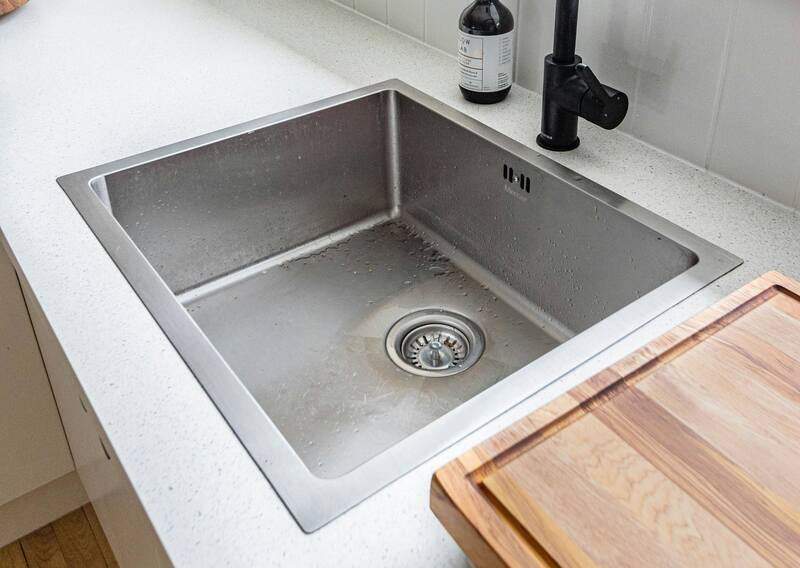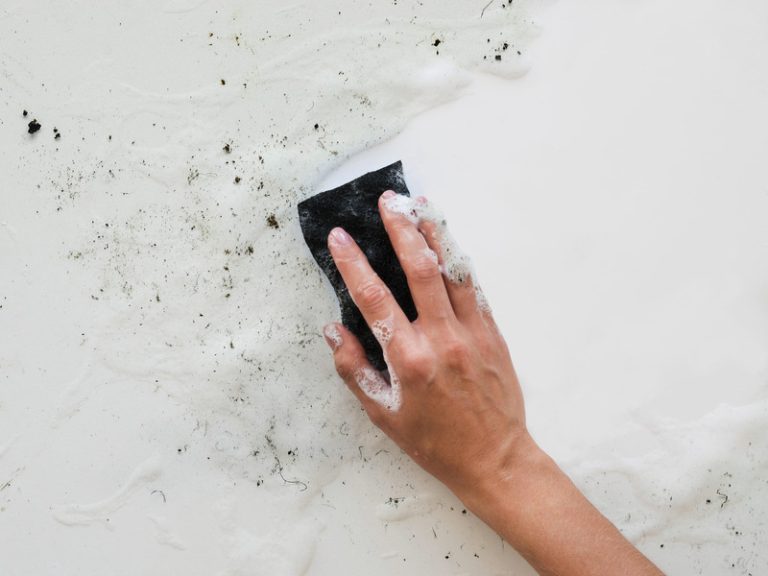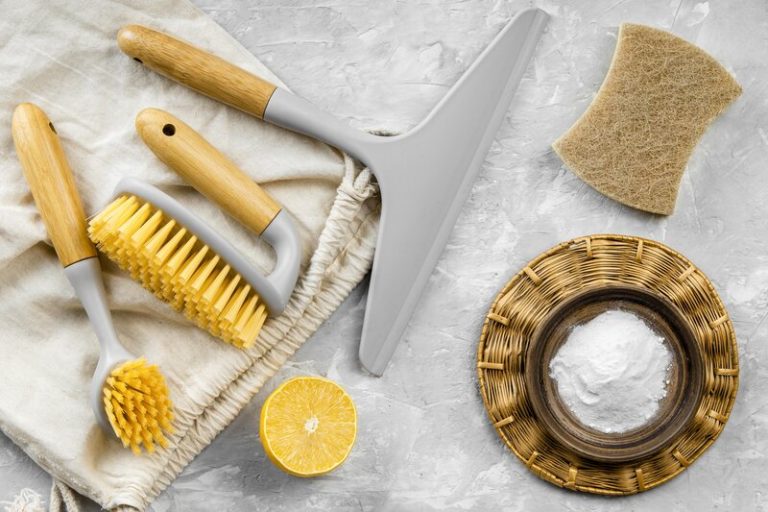Achieving a spotless kitchen sink requires knowing how to clean stainless steel sink effectively. If you’ve ever wondered how do I clean a stainless steel sink, this guide is here to help.
From tackling tough stains to maintaining daily shine, learning how to clean stainless steel sink with simple ingredients like baking soda and vinegar can make all the difference. These easy-to-follow tips will help you restore and preserve the sparkle of your sink, ensuring it remains a standout feature in your kitchen. Dive in and discover the best practices for a gleaming, spotless sink!
Tools and Materials Needed to Stainless Steel Sink
Cleaning a stainless steel sink requires specific items that will effectively remove grime, water spots, and hard water stains while maintaining the sink’s shiny appearance. Essential tools include:
a. Baking Soda
To clean a stainless steel sink effectively, bicarbonate of soda is a must-have tool. Its fine granules tackle tough stains and grease without scratching. To use, mix it with water to form a paste, apply it to stains, and scrub gently. For a fresh sink, use baking soda to neutralise odours by sprinkling it in the drain before cleaning. Regular use of this versatile agent helps maintain a sparkling sink and tackles tough grime effectively.
b. Vinegar
Vinegar is an excellent natural disinfectant for maintaining a stainless steel sink’s shine. To clean your sink, dilute vinegar with water and apply it with a soft cloth. This method removes hard water stains and mineral deposits efficiently. Combining vinegar with baking soda creates a fizzy reaction that helps lift dirt and grime, making it a great option for cleaning both your sink and the drain.
c. Lemon Juice
Lemon juice is a powerful natural cleaner that brightens and deodorises stainless steel sinks. Its high acidity breaks down grease and removes stains effectively. For a sparkling clean, mix equal parts lemon juice and water in a spray bottle, apply it to stains, and wipe after 5-10 minutes. For tough stains, combine lemon juice with baking soda for a fizzy, stain-loosening reaction, enhancing the clean and leaving a fresh scent.
d. Soft Cloth or Sponge
When cleaning a stainless steel sink, use a soft cloth or sponge to avoid scratches and maintain its shine. Harsh pads can dull the surface, so always choose gentle materials. For daily maintenance, rinse the sink after use, wipe it with a soft cloth to remove water spots, and use specialised cleaners occasionally. This approach helps preserve the sink’s appearance and extends its lifespan.
e. Soft-bristled Brush
A soft-bristled brush is ideal for reaching difficult areas of a stainless steel sink, like grooves and corners. It dislodges grime effectively without scratching the surface. Use the brush with a suitable cleaner, allowing it to sit for a few minutes before scrubbing. This method ensures thorough cleaning of hard-to-reach spots and complements other cleaning tools like cloths and sponges for a comprehensive maintenance routine.
f. Microfiber Towel
Microfiber towels are perfect for drying and polishing a stainless steel sink to achieve a streak-free shine. They trap dirt and grime efficiently, reducing the need for excessive scrubbing. For best results, start with a damp towel to lift dirt, avoid fabric softeners to prevent residue, and dry the sink in sections to ensure an even, spotless finish. This method keeps your sink looking pristine and well-maintained.
Step-by-Step Guide on How to Clean Stainless Steel Sink
Cleaning a stainless steel sink efficiently requires a methodical approach using simple steps to ensure every part of the sink is thoroughly cleaned and shines, such as:
a. Rinse the Sink
To begin the process of how to clean stainless steel sink, start by thoroughly rinsing it with warm water to remove any food scraps and loose debris. This initial rinse is crucial for laying the groundwork for a deep clean, as it helps prevent abrasive particles from scratching the surface and removes bacteria and lingering odours.
Use a sprayer nozzle to reach corners and crevices effectively, and make sure to clean the taps and handles, as these areas can also collect grime. Proper rinsing is essential to ensure the entire surface is prepared for further cleaning steps.
b. Sprinkle Baking Soda
Once the sink is rinsed, sprinkle a generous amount of bicarbonate of soda over the entire surface to tackle stains and odours. This common household ingredient is effective for removing stubborn residues left from meals. Allow the bicarbonate of soda to sit for 15-30 minutes so it can penetrate grime and neutralise smells.
For more intense stains, mix the bicarbonate of soda with water to form a paste and apply it directly to the problem areas. Afterward, rinse the sink with warm water and wipe it down to reveal a sparkling finish.
c. Scrub with a Soft Cloth or Sponge
To clean a stainless steel sink effectively, use a soft cloth or sponge to gently scrub the bicarbonate of soda across the surface. Focus on areas with stains or discolouration, applying gentle, circular motions to avoid scratching the sink. Let the baking soda sit for 10-15 minutes before scrubbing to help lift embedded dirt.
After scrubbing, rinse the sink with warm water to remove any remaining residue. For an extra touch, dry the sink with a clean cloth to enhance its shine and prevent water spots, and maintain the sink regularly to prevent future build-up.
d. Rinse with Water
After scrubbing, rinse the stainless steel sink thoroughly with warm water to remove the baking soda and any loosened debris. Warm water helps dissolve residues more effectively than cold water.
Rinse in manageable sections to ensure every part of the sink, including the corners and edges, is properly cleaned. Check for any remaining residue and use a clean cloth or sponge to assist the water flow, ensuring the sink is completely free of cleaning agents and dirt for a pristine finish.
e. Create a Cleaning Solution
For a more intensive clean, create a solution using equal parts vinegar and water, or mix bicarbonate of soda with lemon juice. Vinegar is excellent for routine cleaning and deodorising, cutting through hard water stains effectively.
The combination of bicarbonate of soda and lemon juice is particularly effective for deeper cleans, helping to brighten the sink and tackle tougher stains. Regular use of these solutions can help maintain the shine and extend the life of your stainless steel sink, ensuring it remains spotless.
f. Scrub with Soft-bristled Brush
Use a soft-bristled brush to scrub the cleaning solution into the stainless steel sink, paying special attention to hard-to-reach areas where grime and residue can accumulate. Begin at the edges and work your way inward, focusing on crevices and corners. A brush with medium-sized soft bristles is ideal for lifting dirt without scratching the surface.
Rinse the sink frequently to remove dislodged grime and maintain an effective cleaning routine. This step ensures a comprehensive clean, enhancing both the appearance and hygiene of your sink.
g. Rinse with Water
After scrubbing, rinse the stainless steel sink again with warm water to remove the cleaning solution and any remaining debris. This thorough rinsing step is crucial for eliminating residues from cleaning agents and preventing potential chemical reactions.
Let the warm water flow over the surfaces, using a sponge or cloth to assist in reaching all areas, especially corners and edges. Ensure that all cleaning solution and grime are washed away before drying the sink to prevent watermarks and maintain a clean, polished appearance.
h. Dry with Microfiber Towel
Finally, use a microfiber towel to dry the stainless steel sink, which will help achieve a streak-free shine and enhance its overall appearance. Microfiber cloths are ideal for absorbing moisture without scratching the surface.
Wipe the sink in circular motions to ensure an even shine, paying special attention to corners and edges where water can accumulate. Incorporate this drying step into your regular cleaning routine to keep the sink looking its best, and use a secondary cloth to handle any excess moisture for a flawless finish.
Tips and Tricks for Maintaining a Clean Stainless Steel Sink
Maintaining a clean stainless steel sink involves adopting a few simple tips and tricks that ensure its longevity and shine. Regular daily cleaning, coupled with weekly polishing, can prevent the build-up of grime and hard water stains, keeping your sink looking as good as new.
By utilising effective products and techniques, you can easily maintain the hygiene and aesthetic appeal of your sink, which is essential in every kitchen.
Keeping your stainless steel sink in pristine condition is essential for both its appearance and longevity. Now that you know how to clean stainless steel sink effectively, you can handle daily grime and stubborn stains with ease. If you’re still wondering how do I clean a stainless steel sink to achieve a professional-level shine, remember that thorough and consistent maintenance is key.
For those who prefer a hassle-free approach, TEKA Cleaning offers expert residential cleaning services that cover every aspect of your home, including your stainless steel sink. Our team of professionals uses advanced techniques and high-quality products to ensure your sink—and every corner of your kitchen—sparkles like new.
Don’t let cleaning tasks overwhelm you, let TEKA Cleaning take care of it all! Contact us today at 01223 751 544 to schedule a service and experience the ultimate in cleanliness and convenience. Enjoy a spotless home without the stress—trust TEKA Cleaning to deliver exceptional results every time!
Read also:











